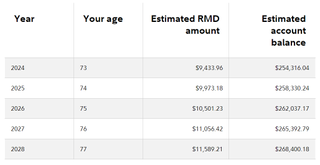How to Calculate RMDs (Required Minimum Distributions) for IRAs
Understand when and how to calculate RMDs and avoid stiff penalties from your tax-deferred IRA.


It pays off to calculate RMDs (Required minimum distributions) as you approach retirement or if you are already retired. RMDs are the minimum annual withdrawals you must make each year from most tax-deferred retirement plans (excluding Roth accounts). Your funds have grown tax-free in these accounts over the years, so RMDs are the government's way of taxing those funds incrementally. That's why RMDs are taxed as income.
Although you may be required to take RMDs from 401(k), 403(b) or other employer-sponsored retirement plans, the calculator we profile here focuses on RMDs from a traditional Individual Retirement Account (IRA).
Starting RMD withdrawals at the right age is critical, and the rules have changed recently.

Sign up for Kiplinger’s Free E-Newsletters
Profit and prosper with the best of expert advice on investing, taxes, retirement, personal finance and more - straight to your e-mail.
Profit and prosper with the best of expert advice - straight to your e-mail.
- In 2020, the age for withdrawing from retirement accounts was increased from 70.5 to 72.
- The SECURE 2.0 Act raised the age to 73 for anyone who turns 73 in 2024 through 2032. You must take your first RMD by April 1 of the year after you turn 73.
- Starting in 2033, the RMD age will increase to 75 for anyone who turns 74 after Dec. 31, 2032.
Not sure how to calculate your RMD? We’ll walk you through the steps and point you to other practical resources to use.
For more detailed information, seek guidance from a qualified financial adviser or tax professional.
Calculate RMDs for a traditional IRA
We recommend using the RMD calculator designed by Fidelity, though you may also search for an RMD calculator on your broker's website. The Fidelity tool allows you to calculate the amount you must withdraw even if you are not yet 73, and accounts for your spouse's age as well. It also projects your RMDs for future years. Follow these steps:
- Input your birthdate into the Fidelity RMD Calculator.
- Choose whether your spouse (if you have one) is your only beneficiary.
- Input your IRA account balance as of December 31 of the previous year.
- Input your spouse's date of birth (if applicable).
- Input your estimated rate of return. This is the average annual growth you expect in your retirement account.
RMD calculation example:
John is a single man who turned 73 in 2024. The balance in his IRA was $250,000 on December 31, 2023, and he estimates it will grow by 5% annually. He has no spouse. This year, his required minimum distribution is $9,433.96. As the graph below shows, his annual RMD will increase over the next four years, but his account balance will not dip below its original value, assuming it continues to earn the estimated 5% interest.

RMD dates to remember
Once you turn 73, it's important to be proactive about taking required minimum distributions for IRAs, or you may face penalties. Also, you can withdraw or use your traditional IRA assets at any time, but a 10% additional tax may apply if you withdraw or use IRA assets before you reach age 59½.
Officially, RMDs are due every December 31, but the IRS allows you some wiggle room for your first withdrawal. If you decide to delay your first withdrawal, you'll have to take a second RMD before December 31. Remember that taking two RMDs in one year creates two taxable events, which may push you into a higher tax bracket.
Penalties
The IRS imposes serious penalties for taking RMDs that are too small. If you withdraw less than required, the IRS takes 50% of the difference between what you pulled out and what you should have withdrawn. You can always take larger distributions, but the required minimum distribution lets you know the smallest withdrawal you can make to meet IRS requirements. Unfortunately, you can’t use withdrawals above the minimum requirement in one year to satisfy RMDs in future years.
What accounts require RMDs?
These are the accounts that will require you to withrdaw RMDs (as long as they are not Roth accounts).
- Traditional IRAs
- Traditional 401(k)s
- Nonprofit 403(b) plans
- Government 457 plans
- Simplified Employee Pension (SEP) IRAs
- Savings Incentive Match Plan for Employees (SIMPLE) IRAs
- Profit-sharing plans
- Other defined contribution plans
You must calculate your RMD for each IRA, and you must withdraw the total amount each year. However, you may make the withdrawal from just one of the IRA accounts. This allows for easier bookkeeping and can help you draw down an IRA that is performing poorly.
Other useful resources
Calculating your RMDs manually.
You may calculate RMDs yourself. Start by determining how much you had in your IRA account as of December 31 of the previous year. Next, you can find your life expectancy factor, or the number of additional years you are expected to live according to actuarial calculations. Divide the account balance by the life expectancy factor to get the RMD.
Going to the source.
You can also visit the IRS website to find additional information on RMDs, such as what they are, the types of retirement plans that require RMDs, the timeline for taking minimum distributions and how the amount is calculated.
Related Content
- Required Minimum Distributions (RMDs): Key Points to Know
- Roth IRAs: What They Are and How They Work
- Rolling Over a 401(k) Into an IRA
- An IRA Contribution Option You Might Not Know
Get Kiplinger Today newsletter — free
Profit and prosper with the best of Kiplinger's advice on investing, taxes, retirement, personal finance and much more. Delivered daily. Enter your email in the box and click Sign Me Up.

For the past 18+ years, Kathryn has highlighted the humanity in personal finance by shaping stories that identify the opportunities and obstacles in managing a person's finances. All the same, she’ll jump on other equally important topics if needed. Kathryn graduated with a degree in Journalism and lives in Duluth, Minnesota. She joined Kiplinger in 2023 as a contributor.
- Ellen B. KennedyRetirement Editor, Kiplinger.com
-
 Want to Retire With $100K a Year? Here's How Much to Save
Want to Retire With $100K a Year? Here's How Much to SaveWhat "magic number" will be enough to generate $100K a year in retirement income? We do the math for you.
By Adam Shell Published
-
 Rethinking Income When You Retire: No Paycheck, No Problem
Rethinking Income When You Retire: No Paycheck, No ProblemWhen you retire, you'll need to adjust to the reality of depending on assets instead of a regular paycheck. For that, you'll need a new financial strategy.
By Joel V. Russo, LUTCF Published
-
 Roth IRA Contribution Limits for 2025
Roth IRA Contribution Limits for 2025Roth IRAs Roth IRA contribution limits have gone up. Here's what you need to know.
By Jackie Stewart Last updated
-
 You May Have to Put Catch-Up Contributions in a Roth 401(k): That's Not a Bad Idea
You May Have to Put Catch-Up Contributions in a Roth 401(k): That's Not a Bad IdeaRoth 401(k) High earners will be required to put their catch-up contributions in a Roth 401(k).
By Sandra Block Published
-
 The 10-Year Rule for Inherited IRAs
The 10-Year Rule for Inherited IRAsKiplinger Tax Letter The IRS’ interpretation of the 10-year clean-out rule on inherited IRAs can be complicated.
By Joy Taylor Last updated
-
 529 to Roth IRA: Should You Rollover Unused Funds Before Year-End?
529 to Roth IRA: Should You Rollover Unused Funds Before Year-End?Thanks to the SECURE 2.0 Act, you can roll over funds from your 529 into a Roth IRA, as long as certain conditions are met.
By Erin Bendig Last updated
-
 An RMD Deadline is Approaching Quickly – And Missing It Could Cost You Big Bucks
An RMD Deadline is Approaching Quickly – And Missing It Could Cost You Big BucksIf you're age 72 or older, take your required minimum distribution now to avoid a big penalty or a double-dip next year.
By Rocky Mengle Published
-
 When RMDs Loom Large, QCDs Offer a Gratifying Tax Break
When RMDs Loom Large, QCDs Offer a Gratifying Tax BreakSend money directly to charity from your traditional IRA, and you won’t owe taxes on the amount you donate. It’s a win-win!
By Scott Tucker, Investment Adviser Representative Published
-
 401(k) Contribution Deadline Coming Soon
401(k) Contribution Deadline Coming SoonYear-end is the common deadline for making max 401(k) contributions that can increase your savings for retirement and help lower your tax bill.
By Kelley R. Taylor Last updated
-
 5 Tax Deadlines for October 17
5 Tax Deadlines for October 17tax deadline Many taxpayers know that October 17 is the due date for filing an extended tax return, but there are other tax deadlines on this date.
By William Neilson Last updated